Collaboration in Speaking and Listening English: Punjab Schools
VerifiedAdded on 2020/05/08
|17
|4492
|384
Report
AI Summary
This report provides an in-depth analysis of the challenges and opportunities surrounding English language education in Punjab government secondary schools. It examines the infrastructure of schools, the crucial role of teacher-student collaboration, and the specific issues faced by schools in rural areas. The research highlights the importance of teacher training and the need to shift the perception of English from a mere subject to a practical language for communication. The report explores various initiatives implemented by the government, such as the RTE Act and the Parho Punjab Project, and discusses the impact of factors like teacher-student ratios and the late introduction of English in the curriculum. It emphasizes the need for improved facilities, increased teacher proficiency, and a greater emphasis on English as a tool for communication to empower students and contribute to societal development. The report concludes that effective collaboration between teachers and students is essential for improving English language proficiency and overall educational outcomes in the region.
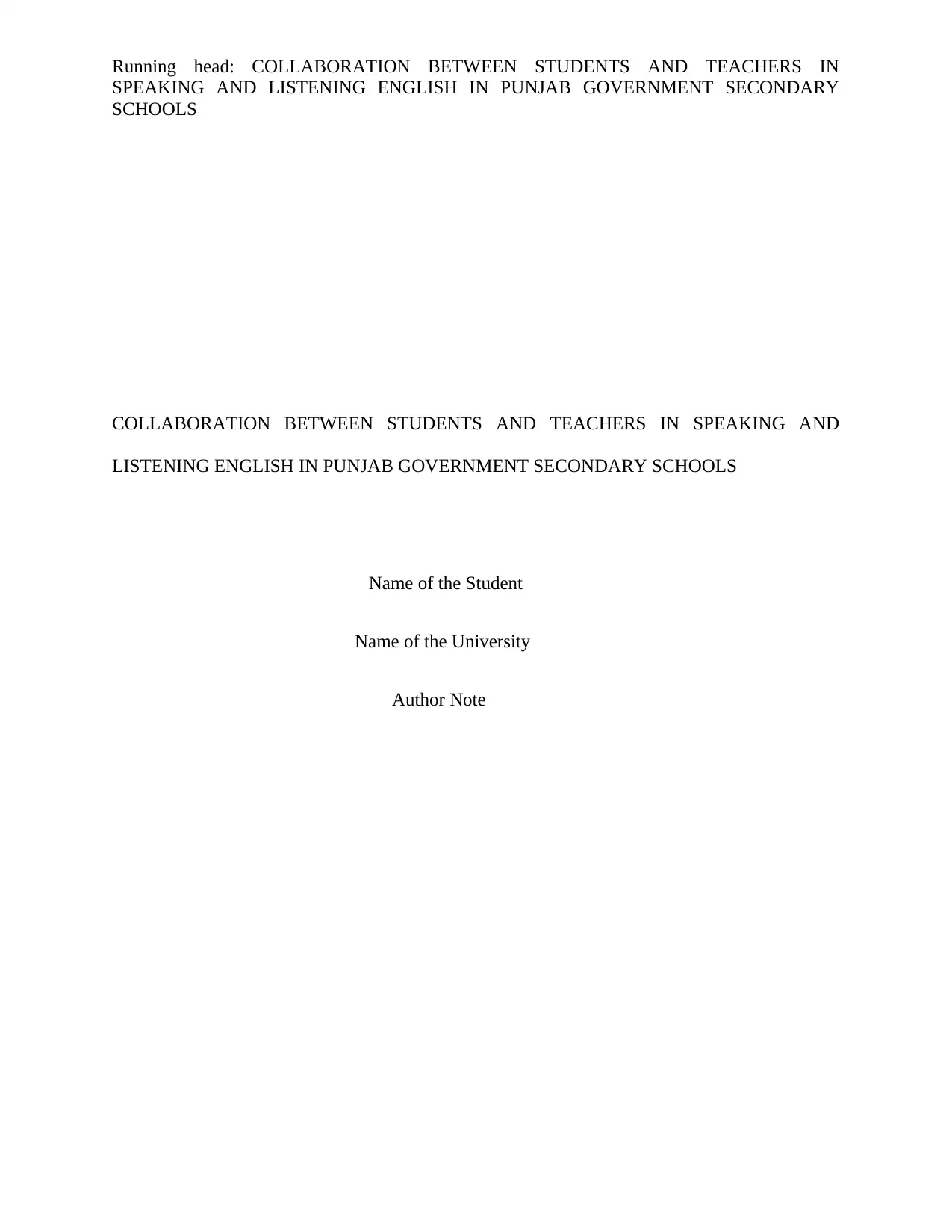
Running head: COLLABORATION BETWEEN STUDENTS AND TEACHERS IN
SPEAKING AND LISTENING ENGLISH IN PUNJAB GOVERNMENT SECONDARY
SCHOOLS
COLLABORATION BETWEEN STUDENTS AND TEACHERS IN SPEAKING AND
LISTENING ENGLISH IN PUNJAB GOVERNMENT SECONDARY SCHOOLS
Name of the Student
Name of the University
Author Note
SPEAKING AND LISTENING ENGLISH IN PUNJAB GOVERNMENT SECONDARY
SCHOOLS
COLLABORATION BETWEEN STUDENTS AND TEACHERS IN SPEAKING AND
LISTENING ENGLISH IN PUNJAB GOVERNMENT SECONDARY SCHOOLS
Name of the Student
Name of the University
Author Note
Paraphrase This Document
Need a fresh take? Get an instant paraphrase of this document with our AI Paraphraser
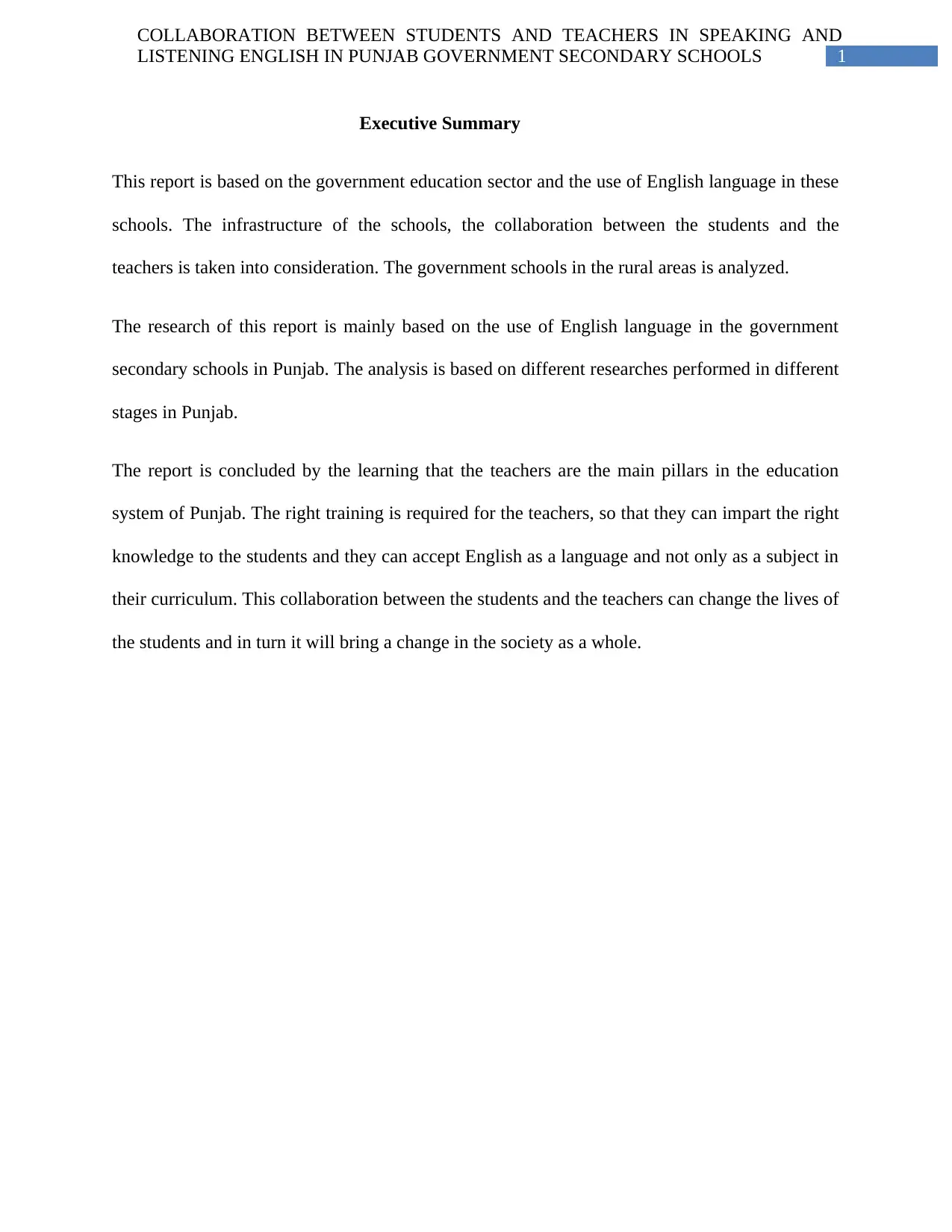
1
COLLABORATION BETWEEN STUDENTS AND TEACHERS IN SPEAKING AND
LISTENING ENGLISH IN PUNJAB GOVERNMENT SECONDARY SCHOOLS
Executive Summary
This report is based on the government education sector and the use of English language in these
schools. The infrastructure of the schools, the collaboration between the students and the
teachers is taken into consideration. The government schools in the rural areas is analyzed.
The research of this report is mainly based on the use of English language in the government
secondary schools in Punjab. The analysis is based on different researches performed in different
stages in Punjab.
The report is concluded by the learning that the teachers are the main pillars in the education
system of Punjab. The right training is required for the teachers, so that they can impart the right
knowledge to the students and they can accept English as a language and not only as a subject in
their curriculum. This collaboration between the students and the teachers can change the lives of
the students and in turn it will bring a change in the society as a whole.
COLLABORATION BETWEEN STUDENTS AND TEACHERS IN SPEAKING AND
LISTENING ENGLISH IN PUNJAB GOVERNMENT SECONDARY SCHOOLS
Executive Summary
This report is based on the government education sector and the use of English language in these
schools. The infrastructure of the schools, the collaboration between the students and the
teachers is taken into consideration. The government schools in the rural areas is analyzed.
The research of this report is mainly based on the use of English language in the government
secondary schools in Punjab. The analysis is based on different researches performed in different
stages in Punjab.
The report is concluded by the learning that the teachers are the main pillars in the education
system of Punjab. The right training is required for the teachers, so that they can impart the right
knowledge to the students and they can accept English as a language and not only as a subject in
their curriculum. This collaboration between the students and the teachers can change the lives of
the students and in turn it will bring a change in the society as a whole.
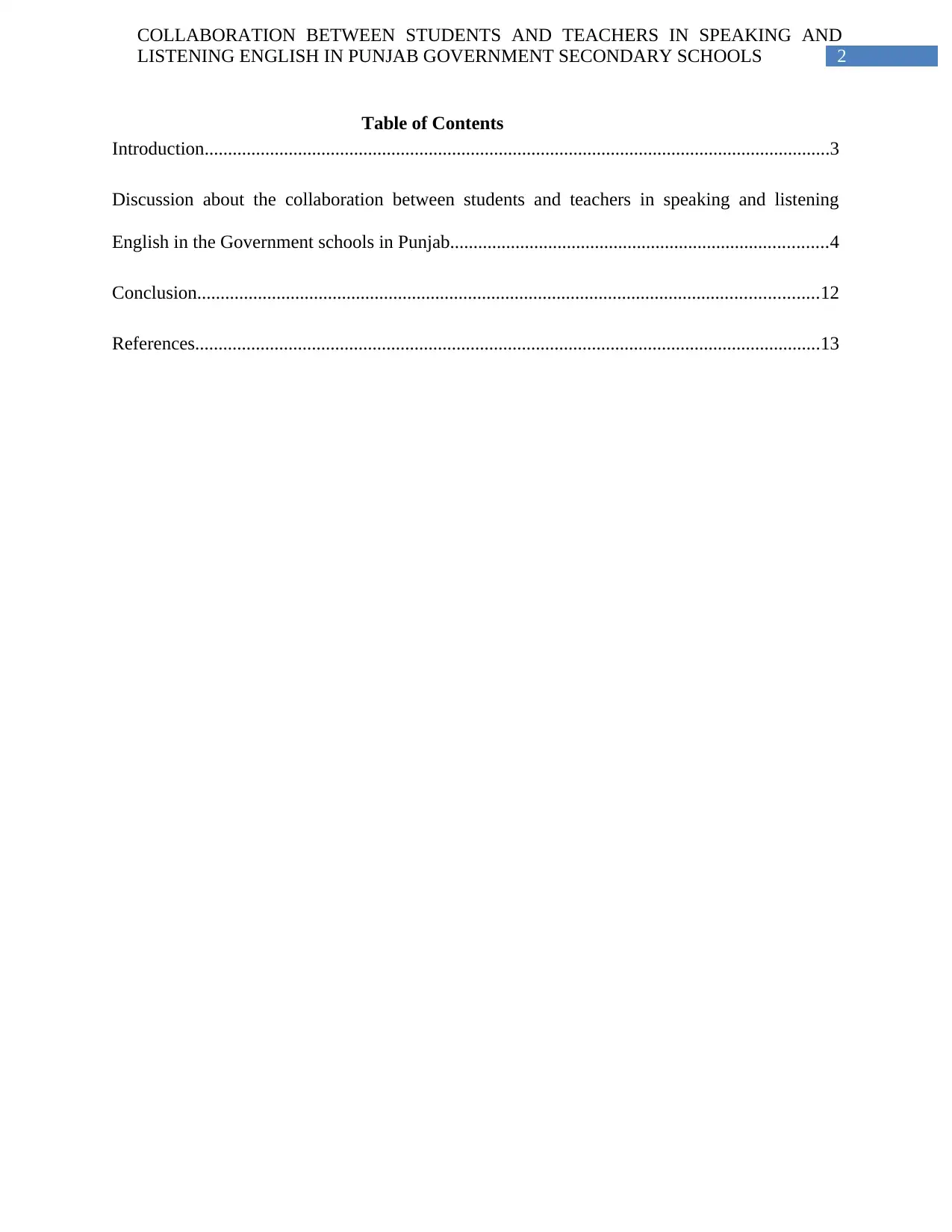
2
COLLABORATION BETWEEN STUDENTS AND TEACHERS IN SPEAKING AND
LISTENING ENGLISH IN PUNJAB GOVERNMENT SECONDARY SCHOOLS
Table of Contents
Introduction......................................................................................................................................3
Discussion about the collaboration between students and teachers in speaking and listening
English in the Government schools in Punjab.................................................................................4
Conclusion.....................................................................................................................................12
References......................................................................................................................................13
COLLABORATION BETWEEN STUDENTS AND TEACHERS IN SPEAKING AND
LISTENING ENGLISH IN PUNJAB GOVERNMENT SECONDARY SCHOOLS
Table of Contents
Introduction......................................................................................................................................3
Discussion about the collaboration between students and teachers in speaking and listening
English in the Government schools in Punjab.................................................................................4
Conclusion.....................................................................................................................................12
References......................................................................................................................................13
⊘ This is a preview!⊘
Do you want full access?
Subscribe today to unlock all pages.

Trusted by 1+ million students worldwide
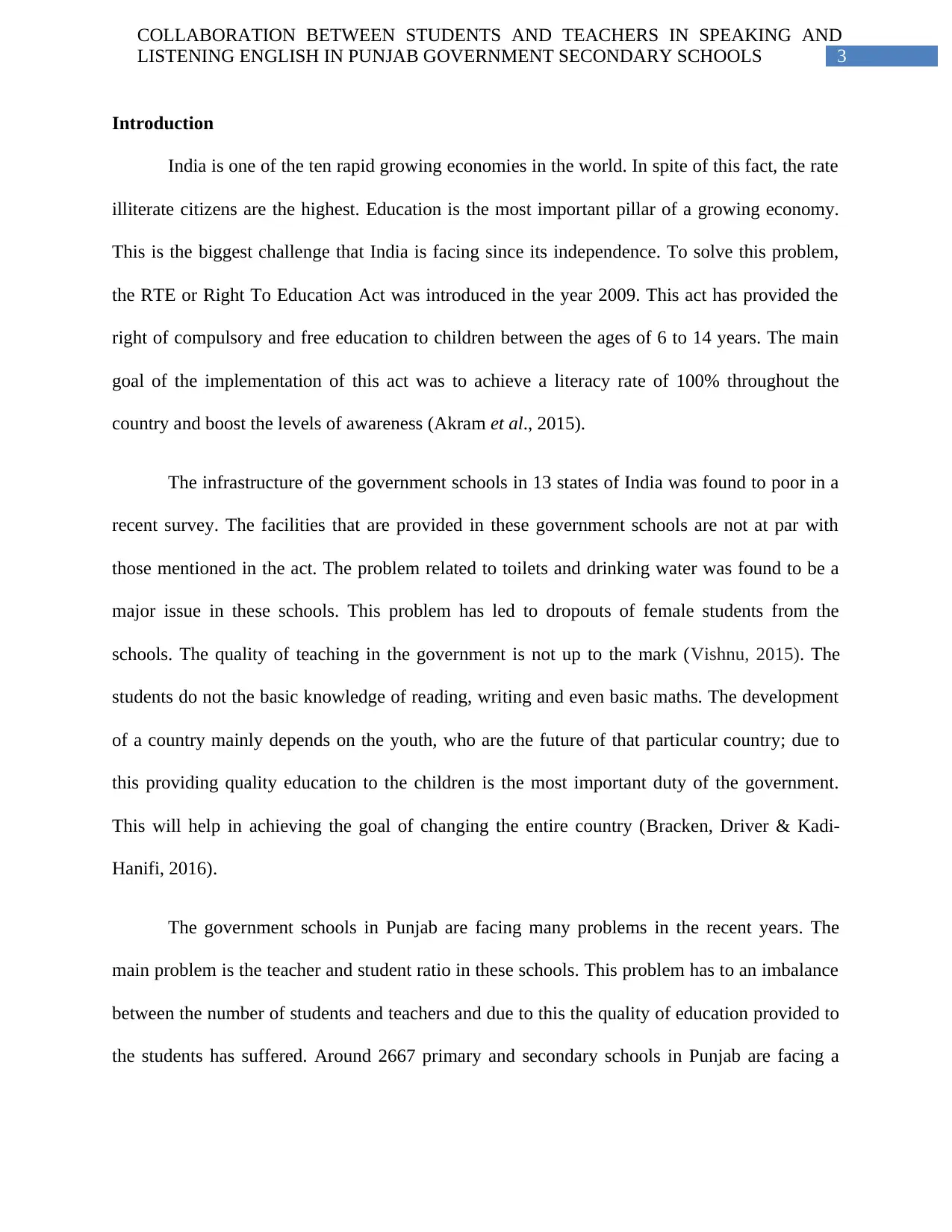
3
COLLABORATION BETWEEN STUDENTS AND TEACHERS IN SPEAKING AND
LISTENING ENGLISH IN PUNJAB GOVERNMENT SECONDARY SCHOOLS
Introduction
India is one of the ten rapid growing economies in the world. In spite of this fact, the rate
illiterate citizens are the highest. Education is the most important pillar of a growing economy.
This is the biggest challenge that India is facing since its independence. To solve this problem,
the RTE or Right To Education Act was introduced in the year 2009. This act has provided the
right of compulsory and free education to children between the ages of 6 to 14 years. The main
goal of the implementation of this act was to achieve a literacy rate of 100% throughout the
country and boost the levels of awareness (Akram et al., 2015).
The infrastructure of the government schools in 13 states of India was found to poor in a
recent survey. The facilities that are provided in these government schools are not at par with
those mentioned in the act. The problem related to toilets and drinking water was found to be a
major issue in these schools. This problem has led to dropouts of female students from the
schools. The quality of teaching in the government is not up to the mark (Vishnu, 2015). The
students do not the basic knowledge of reading, writing and even basic maths. The development
of a country mainly depends on the youth, who are the future of that particular country; due to
this providing quality education to the children is the most important duty of the government.
This will help in achieving the goal of changing the entire country (Bracken, Driver & Kadi-
Hanifi, 2016).
The government schools in Punjab are facing many problems in the recent years. The
main problem is the teacher and student ratio in these schools. This problem has to an imbalance
between the number of students and teachers and due to this the quality of education provided to
the students has suffered. Around 2667 primary and secondary schools in Punjab are facing a
COLLABORATION BETWEEN STUDENTS AND TEACHERS IN SPEAKING AND
LISTENING ENGLISH IN PUNJAB GOVERNMENT SECONDARY SCHOOLS
Introduction
India is one of the ten rapid growing economies in the world. In spite of this fact, the rate
illiterate citizens are the highest. Education is the most important pillar of a growing economy.
This is the biggest challenge that India is facing since its independence. To solve this problem,
the RTE or Right To Education Act was introduced in the year 2009. This act has provided the
right of compulsory and free education to children between the ages of 6 to 14 years. The main
goal of the implementation of this act was to achieve a literacy rate of 100% throughout the
country and boost the levels of awareness (Akram et al., 2015).
The infrastructure of the government schools in 13 states of India was found to poor in a
recent survey. The facilities that are provided in these government schools are not at par with
those mentioned in the act. The problem related to toilets and drinking water was found to be a
major issue in these schools. This problem has led to dropouts of female students from the
schools. The quality of teaching in the government is not up to the mark (Vishnu, 2015). The
students do not the basic knowledge of reading, writing and even basic maths. The development
of a country mainly depends on the youth, who are the future of that particular country; due to
this providing quality education to the children is the most important duty of the government.
This will help in achieving the goal of changing the entire country (Bracken, Driver & Kadi-
Hanifi, 2016).
The government schools in Punjab are facing many problems in the recent years. The
main problem is the teacher and student ratio in these schools. This problem has to an imbalance
between the number of students and teachers and due to this the quality of education provided to
the students has suffered. Around 2667 primary and secondary schools in Punjab are facing a
Paraphrase This Document
Need a fresh take? Get an instant paraphrase of this document with our AI Paraphraser
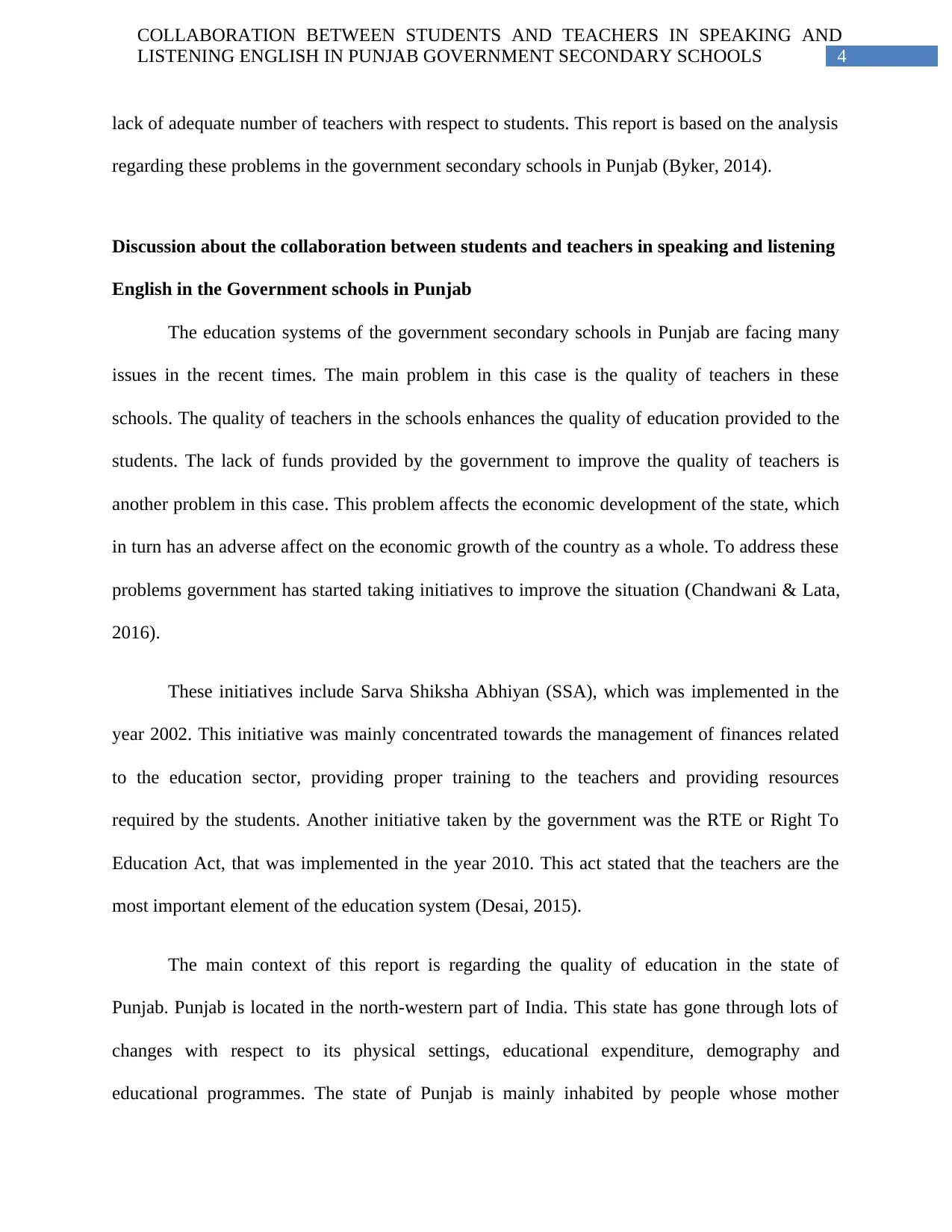
4
COLLABORATION BETWEEN STUDENTS AND TEACHERS IN SPEAKING AND
LISTENING ENGLISH IN PUNJAB GOVERNMENT SECONDARY SCHOOLS
lack of adequate number of teachers with respect to students. This report is based on the analysis
regarding these problems in the government secondary schools in Punjab (Byker, 2014).
Discussion about the collaboration between students and teachers in speaking and listening
English in the Government schools in Punjab
The education systems of the government secondary schools in Punjab are facing many
issues in the recent times. The main problem in this case is the quality of teachers in these
schools. The quality of teachers in the schools enhances the quality of education provided to the
students. The lack of funds provided by the government to improve the quality of teachers is
another problem in this case. This problem affects the economic development of the state, which
in turn has an adverse affect on the economic growth of the country as a whole. To address these
problems government has started taking initiatives to improve the situation (Chandwani & Lata,
2016).
These initiatives include Sarva Shiksha Abhiyan (SSA), which was implemented in the
year 2002. This initiative was mainly concentrated towards the management of finances related
to the education sector, providing proper training to the teachers and providing resources
required by the students. Another initiative taken by the government was the RTE or Right To
Education Act, that was implemented in the year 2010. This act stated that the teachers are the
most important element of the education system (Desai, 2015).
The main context of this report is regarding the quality of education in the state of
Punjab. Punjab is located in the north-western part of India. This state has gone through lots of
changes with respect to its physical settings, educational expenditure, demography and
educational programmes. The state of Punjab is mainly inhabited by people whose mother
COLLABORATION BETWEEN STUDENTS AND TEACHERS IN SPEAKING AND
LISTENING ENGLISH IN PUNJAB GOVERNMENT SECONDARY SCHOOLS
lack of adequate number of teachers with respect to students. This report is based on the analysis
regarding these problems in the government secondary schools in Punjab (Byker, 2014).
Discussion about the collaboration between students and teachers in speaking and listening
English in the Government schools in Punjab
The education systems of the government secondary schools in Punjab are facing many
issues in the recent times. The main problem in this case is the quality of teachers in these
schools. The quality of teachers in the schools enhances the quality of education provided to the
students. The lack of funds provided by the government to improve the quality of teachers is
another problem in this case. This problem affects the economic development of the state, which
in turn has an adverse affect on the economic growth of the country as a whole. To address these
problems government has started taking initiatives to improve the situation (Chandwani & Lata,
2016).
These initiatives include Sarva Shiksha Abhiyan (SSA), which was implemented in the
year 2002. This initiative was mainly concentrated towards the management of finances related
to the education sector, providing proper training to the teachers and providing resources
required by the students. Another initiative taken by the government was the RTE or Right To
Education Act, that was implemented in the year 2010. This act stated that the teachers are the
most important element of the education system (Desai, 2015).
The main context of this report is regarding the quality of education in the state of
Punjab. Punjab is located in the north-western part of India. This state has gone through lots of
changes with respect to its physical settings, educational expenditure, demography and
educational programmes. The state of Punjab is mainly inhabited by people whose mother
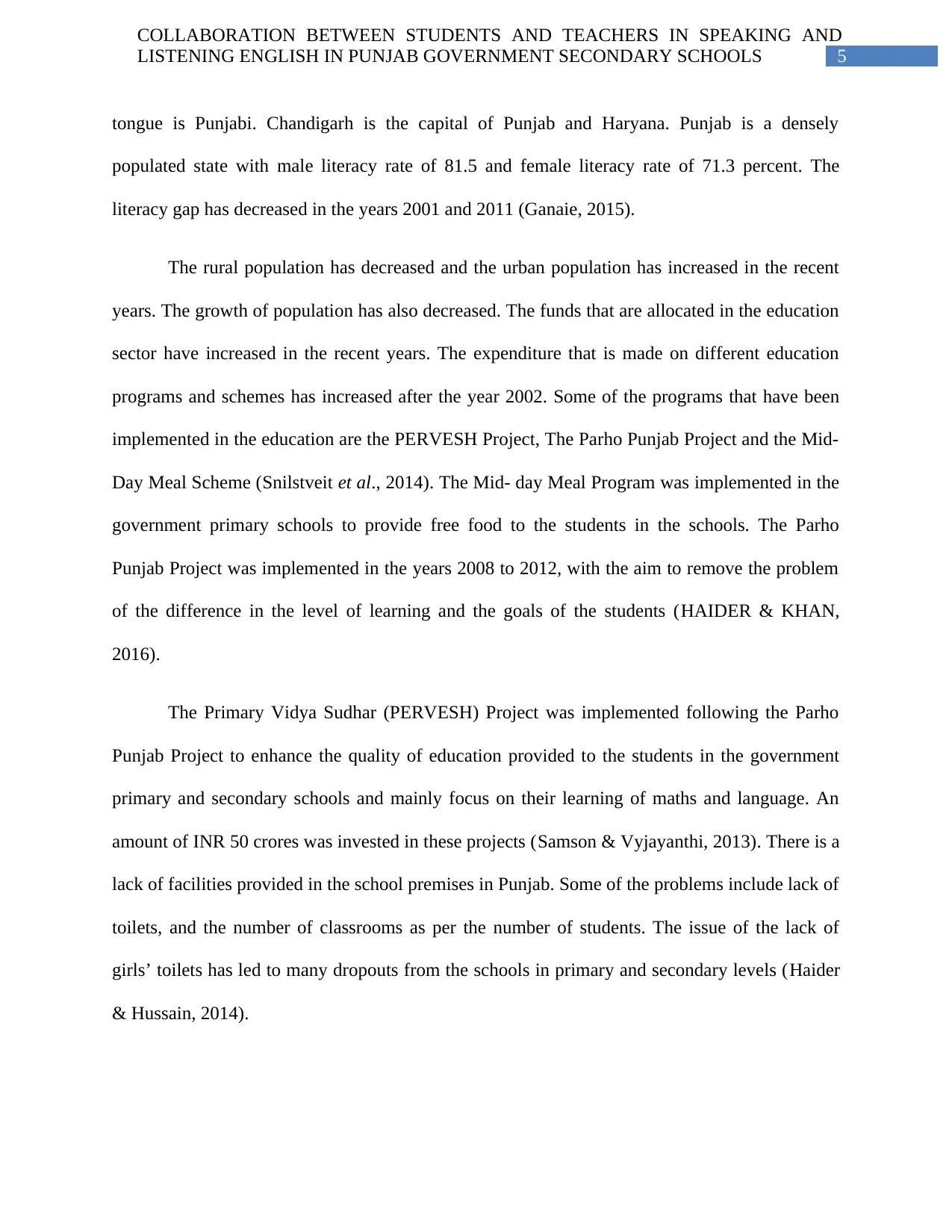
5
COLLABORATION BETWEEN STUDENTS AND TEACHERS IN SPEAKING AND
LISTENING ENGLISH IN PUNJAB GOVERNMENT SECONDARY SCHOOLS
tongue is Punjabi. Chandigarh is the capital of Punjab and Haryana. Punjab is a densely
populated state with male literacy rate of 81.5 and female literacy rate of 71.3 percent. The
literacy gap has decreased in the years 2001 and 2011 (Ganaie, 2015).
The rural population has decreased and the urban population has increased in the recent
years. The growth of population has also decreased. The funds that are allocated in the education
sector have increased in the recent years. The expenditure that is made on different education
programs and schemes has increased after the year 2002. Some of the programs that have been
implemented in the education are the PERVESH Project, The Parho Punjab Project and the Mid-
Day Meal Scheme (Snilstveit et al., 2014). The Mid- day Meal Program was implemented in the
government primary schools to provide free food to the students in the schools. The Parho
Punjab Project was implemented in the years 2008 to 2012, with the aim to remove the problem
of the difference in the level of learning and the goals of the students (HAIDER & KHAN,
2016).
The Primary Vidya Sudhar (PERVESH) Project was implemented following the Parho
Punjab Project to enhance the quality of education provided to the students in the government
primary and secondary schools and mainly focus on their learning of maths and language. An
amount of INR 50 crores was invested in these projects (Samson & Vyjayanthi, 2013). There is a
lack of facilities provided in the school premises in Punjab. Some of the problems include lack of
toilets, and the number of classrooms as per the number of students. The issue of the lack of
girls’ toilets has led to many dropouts from the schools in primary and secondary levels (Haider
& Hussain, 2014).
COLLABORATION BETWEEN STUDENTS AND TEACHERS IN SPEAKING AND
LISTENING ENGLISH IN PUNJAB GOVERNMENT SECONDARY SCHOOLS
tongue is Punjabi. Chandigarh is the capital of Punjab and Haryana. Punjab is a densely
populated state with male literacy rate of 81.5 and female literacy rate of 71.3 percent. The
literacy gap has decreased in the years 2001 and 2011 (Ganaie, 2015).
The rural population has decreased and the urban population has increased in the recent
years. The growth of population has also decreased. The funds that are allocated in the education
sector have increased in the recent years. The expenditure that is made on different education
programs and schemes has increased after the year 2002. Some of the programs that have been
implemented in the education are the PERVESH Project, The Parho Punjab Project and the Mid-
Day Meal Scheme (Snilstveit et al., 2014). The Mid- day Meal Program was implemented in the
government primary schools to provide free food to the students in the schools. The Parho
Punjab Project was implemented in the years 2008 to 2012, with the aim to remove the problem
of the difference in the level of learning and the goals of the students (HAIDER & KHAN,
2016).
The Primary Vidya Sudhar (PERVESH) Project was implemented following the Parho
Punjab Project to enhance the quality of education provided to the students in the government
primary and secondary schools and mainly focus on their learning of maths and language. An
amount of INR 50 crores was invested in these projects (Samson & Vyjayanthi, 2013). There is a
lack of facilities provided in the school premises in Punjab. Some of the problems include lack of
toilets, and the number of classrooms as per the number of students. The issue of the lack of
girls’ toilets has led to many dropouts from the schools in primary and secondary levels (Haider
& Hussain, 2014).
⊘ This is a preview!⊘
Do you want full access?
Subscribe today to unlock all pages.

Trusted by 1+ million students worldwide
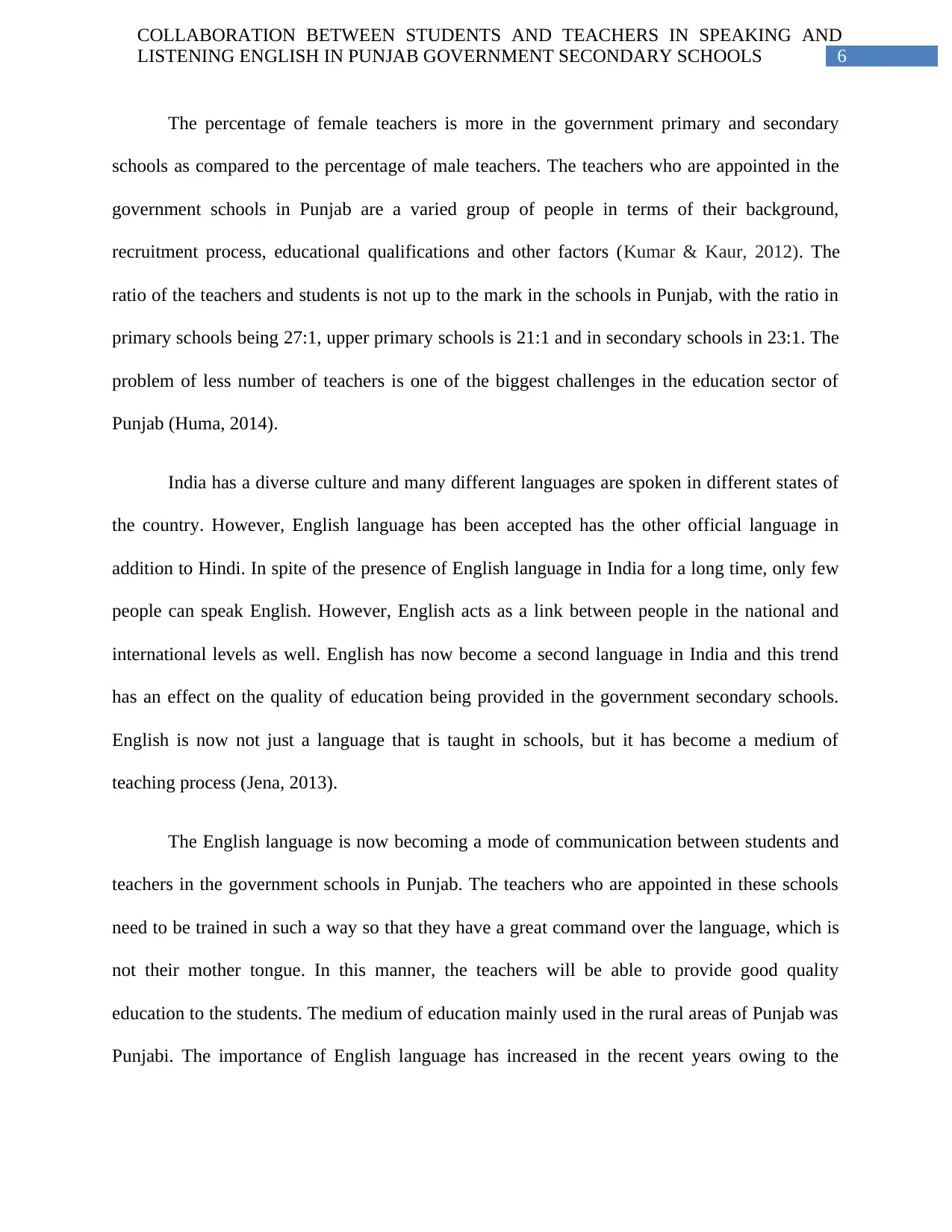
6
COLLABORATION BETWEEN STUDENTS AND TEACHERS IN SPEAKING AND
LISTENING ENGLISH IN PUNJAB GOVERNMENT SECONDARY SCHOOLS
The percentage of female teachers is more in the government primary and secondary
schools as compared to the percentage of male teachers. The teachers who are appointed in the
government schools in Punjab are a varied group of people in terms of their background,
recruitment process, educational qualifications and other factors (Kumar & Kaur, 2012). The
ratio of the teachers and students is not up to the mark in the schools in Punjab, with the ratio in
primary schools being 27:1, upper primary schools is 21:1 and in secondary schools in 23:1. The
problem of less number of teachers is one of the biggest challenges in the education sector of
Punjab (Huma, 2014).
India has a diverse culture and many different languages are spoken in different states of
the country. However, English language has been accepted has the other official language in
addition to Hindi. In spite of the presence of English language in India for a long time, only few
people can speak English. However, English acts as a link between people in the national and
international levels as well. English has now become a second language in India and this trend
has an effect on the quality of education being provided in the government secondary schools.
English is now not just a language that is taught in schools, but it has become a medium of
teaching process (Jena, 2013).
The English language is now becoming a mode of communication between students and
teachers in the government schools in Punjab. The teachers who are appointed in these schools
need to be trained in such a way so that they have a great command over the language, which is
not their mother tongue. In this manner, the teachers will be able to provide good quality
education to the students. The medium of education mainly used in the rural areas of Punjab was
Punjabi. The importance of English language has increased in the recent years owing to the
COLLABORATION BETWEEN STUDENTS AND TEACHERS IN SPEAKING AND
LISTENING ENGLISH IN PUNJAB GOVERNMENT SECONDARY SCHOOLS
The percentage of female teachers is more in the government primary and secondary
schools as compared to the percentage of male teachers. The teachers who are appointed in the
government schools in Punjab are a varied group of people in terms of their background,
recruitment process, educational qualifications and other factors (Kumar & Kaur, 2012). The
ratio of the teachers and students is not up to the mark in the schools in Punjab, with the ratio in
primary schools being 27:1, upper primary schools is 21:1 and in secondary schools in 23:1. The
problem of less number of teachers is one of the biggest challenges in the education sector of
Punjab (Huma, 2014).
India has a diverse culture and many different languages are spoken in different states of
the country. However, English language has been accepted has the other official language in
addition to Hindi. In spite of the presence of English language in India for a long time, only few
people can speak English. However, English acts as a link between people in the national and
international levels as well. English has now become a second language in India and this trend
has an effect on the quality of education being provided in the government secondary schools.
English is now not just a language that is taught in schools, but it has become a medium of
teaching process (Jena, 2013).
The English language is now becoming a mode of communication between students and
teachers in the government schools in Punjab. The teachers who are appointed in these schools
need to be trained in such a way so that they have a great command over the language, which is
not their mother tongue. In this manner, the teachers will be able to provide good quality
education to the students. The medium of education mainly used in the rural areas of Punjab was
Punjabi. The importance of English language has increased in the recent years owing to the
Paraphrase This Document
Need a fresh take? Get an instant paraphrase of this document with our AI Paraphraser
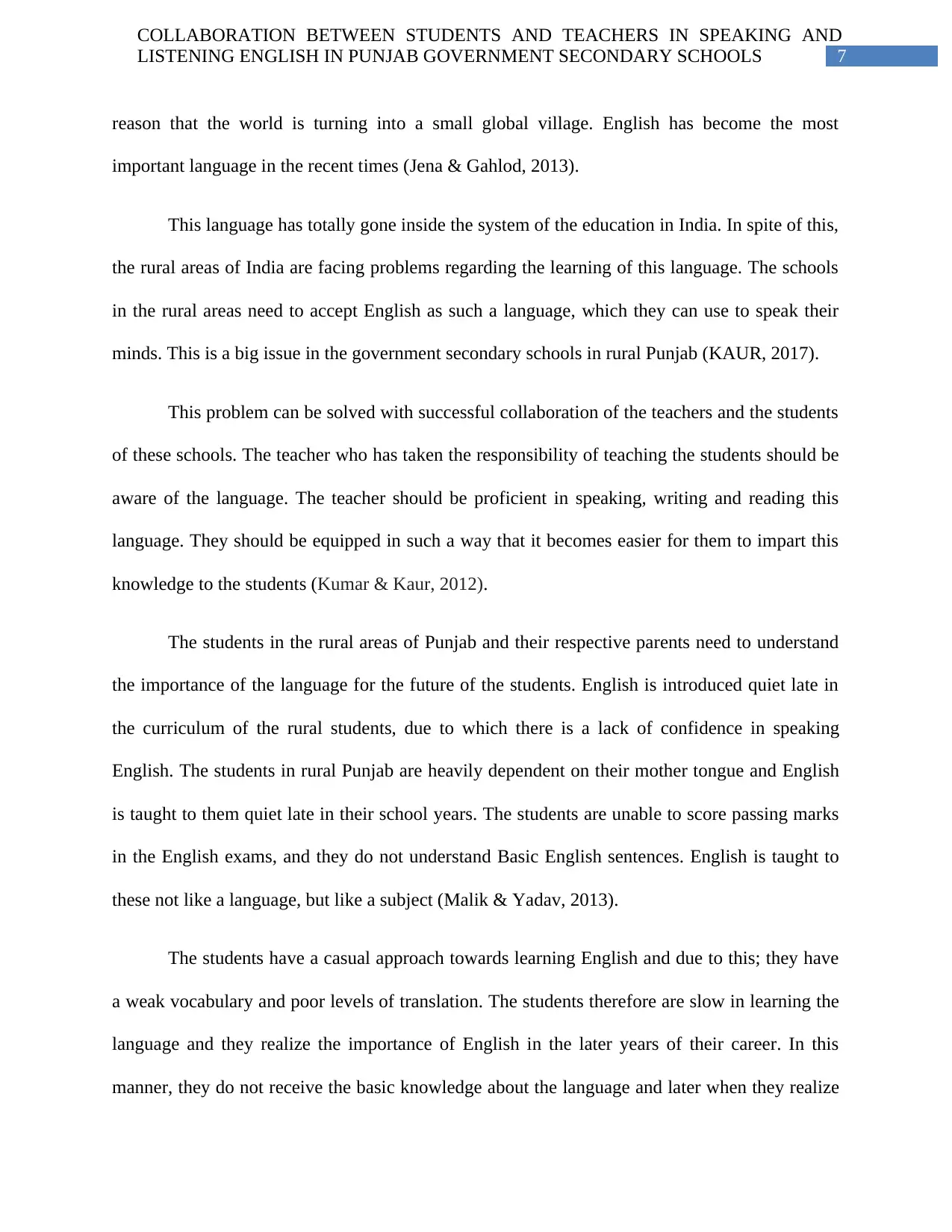
7
COLLABORATION BETWEEN STUDENTS AND TEACHERS IN SPEAKING AND
LISTENING ENGLISH IN PUNJAB GOVERNMENT SECONDARY SCHOOLS
reason that the world is turning into a small global village. English has become the most
important language in the recent times (Jena & Gahlod, 2013).
This language has totally gone inside the system of the education in India. In spite of this,
the rural areas of India are facing problems regarding the learning of this language. The schools
in the rural areas need to accept English as such a language, which they can use to speak their
minds. This is a big issue in the government secondary schools in rural Punjab (KAUR, 2017).
This problem can be solved with successful collaboration of the teachers and the students
of these schools. The teacher who has taken the responsibility of teaching the students should be
aware of the language. The teacher should be proficient in speaking, writing and reading this
language. They should be equipped in such a way that it becomes easier for them to impart this
knowledge to the students (Kumar & Kaur, 2012).
The students in the rural areas of Punjab and their respective parents need to understand
the importance of the language for the future of the students. English is introduced quiet late in
the curriculum of the rural students, due to which there is a lack of confidence in speaking
English. The students in rural Punjab are heavily dependent on their mother tongue and English
is taught to them quiet late in their school years. The students are unable to score passing marks
in the English exams, and they do not understand Basic English sentences. English is taught to
these not like a language, but like a subject (Malik & Yadav, 2013).
The students have a casual approach towards learning English and due to this; they have
a weak vocabulary and poor levels of translation. The students therefore are slow in learning the
language and they realize the importance of English in the later years of their career. In this
manner, they do not receive the basic knowledge about the language and later when they realize
COLLABORATION BETWEEN STUDENTS AND TEACHERS IN SPEAKING AND
LISTENING ENGLISH IN PUNJAB GOVERNMENT SECONDARY SCHOOLS
reason that the world is turning into a small global village. English has become the most
important language in the recent times (Jena & Gahlod, 2013).
This language has totally gone inside the system of the education in India. In spite of this,
the rural areas of India are facing problems regarding the learning of this language. The schools
in the rural areas need to accept English as such a language, which they can use to speak their
minds. This is a big issue in the government secondary schools in rural Punjab (KAUR, 2017).
This problem can be solved with successful collaboration of the teachers and the students
of these schools. The teacher who has taken the responsibility of teaching the students should be
aware of the language. The teacher should be proficient in speaking, writing and reading this
language. They should be equipped in such a way that it becomes easier for them to impart this
knowledge to the students (Kumar & Kaur, 2012).
The students in the rural areas of Punjab and their respective parents need to understand
the importance of the language for the future of the students. English is introduced quiet late in
the curriculum of the rural students, due to which there is a lack of confidence in speaking
English. The students in rural Punjab are heavily dependent on their mother tongue and English
is taught to them quiet late in their school years. The students are unable to score passing marks
in the English exams, and they do not understand Basic English sentences. English is taught to
these not like a language, but like a subject (Malik & Yadav, 2013).
The students have a casual approach towards learning English and due to this; they have
a weak vocabulary and poor levels of translation. The students therefore are slow in learning the
language and they realize the importance of English in the later years of their career. In this
manner, they do not receive the basic knowledge about the language and later when they realize
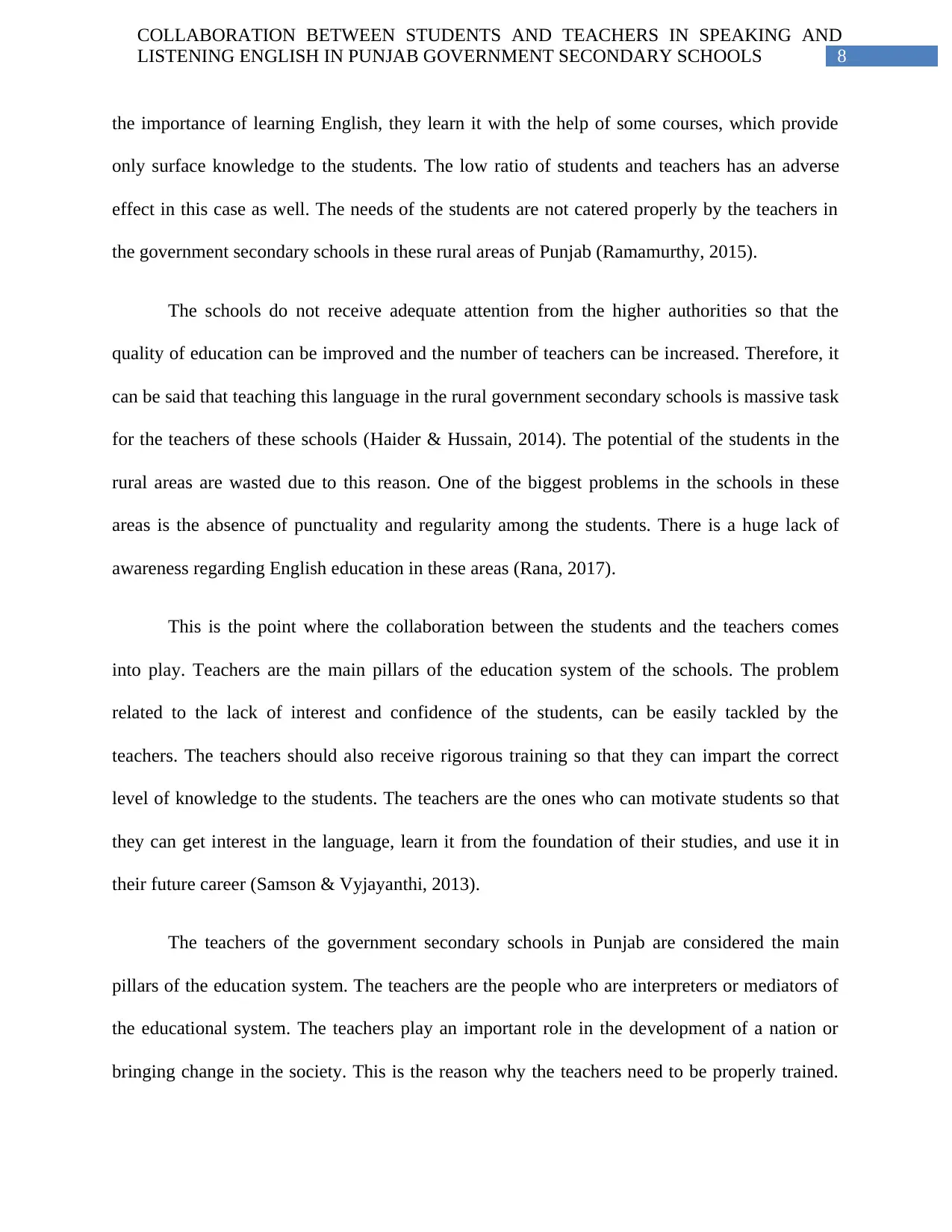
8
COLLABORATION BETWEEN STUDENTS AND TEACHERS IN SPEAKING AND
LISTENING ENGLISH IN PUNJAB GOVERNMENT SECONDARY SCHOOLS
the importance of learning English, they learn it with the help of some courses, which provide
only surface knowledge to the students. The low ratio of students and teachers has an adverse
effect in this case as well. The needs of the students are not catered properly by the teachers in
the government secondary schools in these rural areas of Punjab (Ramamurthy, 2015).
The schools do not receive adequate attention from the higher authorities so that the
quality of education can be improved and the number of teachers can be increased. Therefore, it
can be said that teaching this language in the rural government secondary schools is massive task
for the teachers of these schools (Haider & Hussain, 2014). The potential of the students in the
rural areas are wasted due to this reason. One of the biggest problems in the schools in these
areas is the absence of punctuality and regularity among the students. There is a huge lack of
awareness regarding English education in these areas (Rana, 2017).
This is the point where the collaboration between the students and the teachers comes
into play. Teachers are the main pillars of the education system of the schools. The problem
related to the lack of interest and confidence of the students, can be easily tackled by the
teachers. The teachers should also receive rigorous training so that they can impart the correct
level of knowledge to the students. The teachers are the ones who can motivate students so that
they can get interest in the language, learn it from the foundation of their studies, and use it in
their future career (Samson & Vyjayanthi, 2013).
The teachers of the government secondary schools in Punjab are considered the main
pillars of the education system. The teachers are the people who are interpreters or mediators of
the educational system. The teachers play an important role in the development of a nation or
bringing change in the society. This is the reason why the teachers need to be properly trained.
COLLABORATION BETWEEN STUDENTS AND TEACHERS IN SPEAKING AND
LISTENING ENGLISH IN PUNJAB GOVERNMENT SECONDARY SCHOOLS
the importance of learning English, they learn it with the help of some courses, which provide
only surface knowledge to the students. The low ratio of students and teachers has an adverse
effect in this case as well. The needs of the students are not catered properly by the teachers in
the government secondary schools in these rural areas of Punjab (Ramamurthy, 2015).
The schools do not receive adequate attention from the higher authorities so that the
quality of education can be improved and the number of teachers can be increased. Therefore, it
can be said that teaching this language in the rural government secondary schools is massive task
for the teachers of these schools (Haider & Hussain, 2014). The potential of the students in the
rural areas are wasted due to this reason. One of the biggest problems in the schools in these
areas is the absence of punctuality and regularity among the students. There is a huge lack of
awareness regarding English education in these areas (Rana, 2017).
This is the point where the collaboration between the students and the teachers comes
into play. Teachers are the main pillars of the education system of the schools. The problem
related to the lack of interest and confidence of the students, can be easily tackled by the
teachers. The teachers should also receive rigorous training so that they can impart the correct
level of knowledge to the students. The teachers are the ones who can motivate students so that
they can get interest in the language, learn it from the foundation of their studies, and use it in
their future career (Samson & Vyjayanthi, 2013).
The teachers of the government secondary schools in Punjab are considered the main
pillars of the education system. The teachers are the people who are interpreters or mediators of
the educational system. The teachers play an important role in the development of a nation or
bringing change in the society. This is the reason why the teachers need to be properly trained.
⊘ This is a preview!⊘
Do you want full access?
Subscribe today to unlock all pages.

Trusted by 1+ million students worldwide
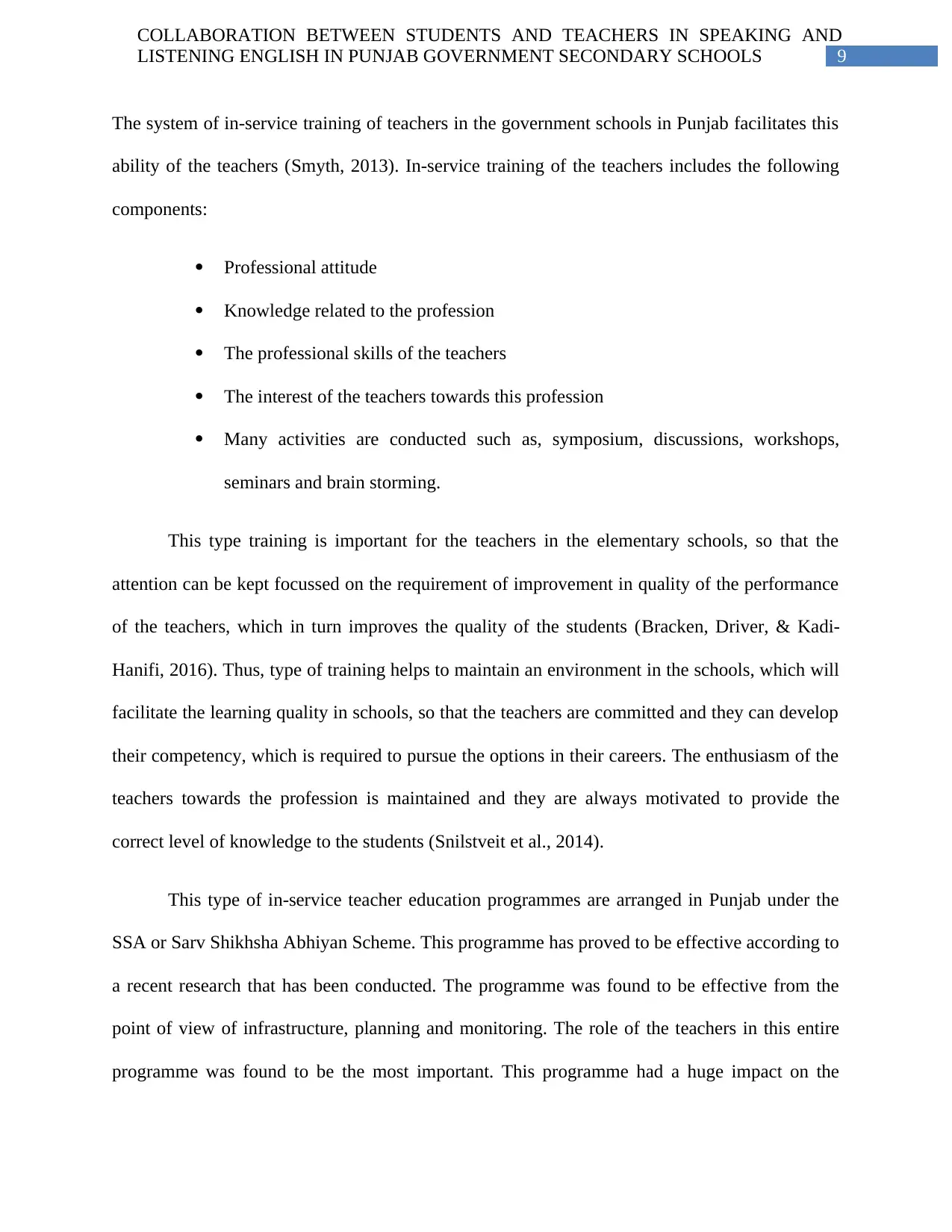
9
COLLABORATION BETWEEN STUDENTS AND TEACHERS IN SPEAKING AND
LISTENING ENGLISH IN PUNJAB GOVERNMENT SECONDARY SCHOOLS
The system of in-service training of teachers in the government schools in Punjab facilitates this
ability of the teachers (Smyth, 2013). In-service training of the teachers includes the following
components:
Professional attitude
Knowledge related to the profession
The professional skills of the teachers
The interest of the teachers towards this profession
Many activities are conducted such as, symposium, discussions, workshops,
seminars and brain storming.
This type training is important for the teachers in the elementary schools, so that the
attention can be kept focussed on the requirement of improvement in quality of the performance
of the teachers, which in turn improves the quality of the students (Bracken, Driver, & Kadi-
Hanifi, 2016). Thus, type of training helps to maintain an environment in the schools, which will
facilitate the learning quality in schools, so that the teachers are committed and they can develop
their competency, which is required to pursue the options in their careers. The enthusiasm of the
teachers towards the profession is maintained and they are always motivated to provide the
correct level of knowledge to the students (Snilstveit et al., 2014).
This type of in-service teacher education programmes are arranged in Punjab under the
SSA or Sarv Shikhsha Abhiyan Scheme. This programme has proved to be effective according to
a recent research that has been conducted. The programme was found to be effective from the
point of view of infrastructure, planning and monitoring. The role of the teachers in this entire
programme was found to be the most important. This programme had a huge impact on the
COLLABORATION BETWEEN STUDENTS AND TEACHERS IN SPEAKING AND
LISTENING ENGLISH IN PUNJAB GOVERNMENT SECONDARY SCHOOLS
The system of in-service training of teachers in the government schools in Punjab facilitates this
ability of the teachers (Smyth, 2013). In-service training of the teachers includes the following
components:
Professional attitude
Knowledge related to the profession
The professional skills of the teachers
The interest of the teachers towards this profession
Many activities are conducted such as, symposium, discussions, workshops,
seminars and brain storming.
This type training is important for the teachers in the elementary schools, so that the
attention can be kept focussed on the requirement of improvement in quality of the performance
of the teachers, which in turn improves the quality of the students (Bracken, Driver, & Kadi-
Hanifi, 2016). Thus, type of training helps to maintain an environment in the schools, which will
facilitate the learning quality in schools, so that the teachers are committed and they can develop
their competency, which is required to pursue the options in their careers. The enthusiasm of the
teachers towards the profession is maintained and they are always motivated to provide the
correct level of knowledge to the students (Snilstveit et al., 2014).
This type of in-service teacher education programmes are arranged in Punjab under the
SSA or Sarv Shikhsha Abhiyan Scheme. This programme has proved to be effective according to
a recent research that has been conducted. The programme was found to be effective from the
point of view of infrastructure, planning and monitoring. The role of the teachers in this entire
programme was found to be the most important. This programme had a huge impact on the
Paraphrase This Document
Need a fresh take? Get an instant paraphrase of this document with our AI Paraphraser
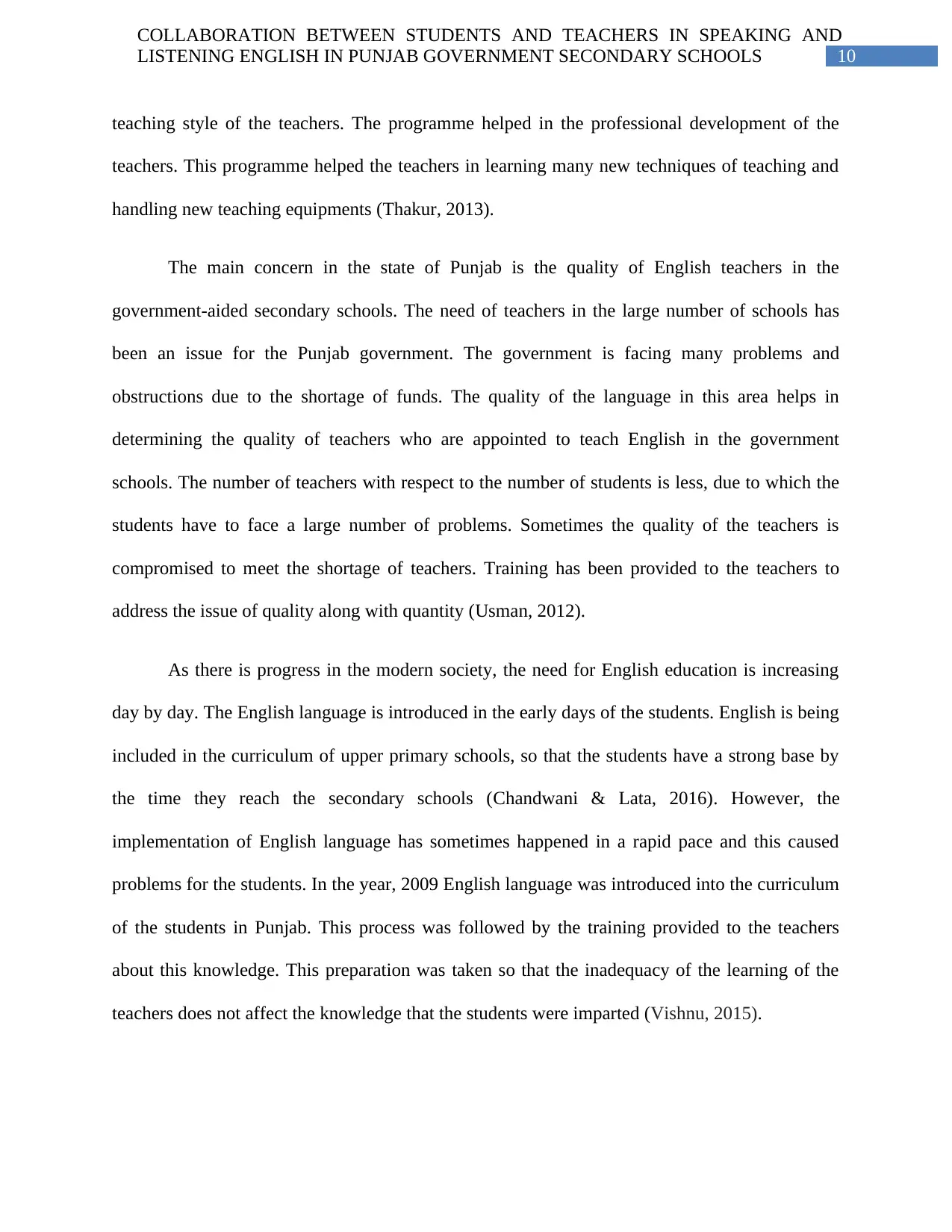
10
COLLABORATION BETWEEN STUDENTS AND TEACHERS IN SPEAKING AND
LISTENING ENGLISH IN PUNJAB GOVERNMENT SECONDARY SCHOOLS
teaching style of the teachers. The programme helped in the professional development of the
teachers. This programme helped the teachers in learning many new techniques of teaching and
handling new teaching equipments (Thakur, 2013).
The main concern in the state of Punjab is the quality of English teachers in the
government-aided secondary schools. The need of teachers in the large number of schools has
been an issue for the Punjab government. The government is facing many problems and
obstructions due to the shortage of funds. The quality of the language in this area helps in
determining the quality of teachers who are appointed to teach English in the government
schools. The number of teachers with respect to the number of students is less, due to which the
students have to face a large number of problems. Sometimes the quality of the teachers is
compromised to meet the shortage of teachers. Training has been provided to the teachers to
address the issue of quality along with quantity (Usman, 2012).
As there is progress in the modern society, the need for English education is increasing
day by day. The English language is introduced in the early days of the students. English is being
included in the curriculum of upper primary schools, so that the students have a strong base by
the time they reach the secondary schools (Chandwani & Lata, 2016). However, the
implementation of English language has sometimes happened in a rapid pace and this caused
problems for the students. In the year, 2009 English language was introduced into the curriculum
of the students in Punjab. This process was followed by the training provided to the teachers
about this knowledge. This preparation was taken so that the inadequacy of the learning of the
teachers does not affect the knowledge that the students were imparted (Vishnu, 2015).
COLLABORATION BETWEEN STUDENTS AND TEACHERS IN SPEAKING AND
LISTENING ENGLISH IN PUNJAB GOVERNMENT SECONDARY SCHOOLS
teaching style of the teachers. The programme helped in the professional development of the
teachers. This programme helped the teachers in learning many new techniques of teaching and
handling new teaching equipments (Thakur, 2013).
The main concern in the state of Punjab is the quality of English teachers in the
government-aided secondary schools. The need of teachers in the large number of schools has
been an issue for the Punjab government. The government is facing many problems and
obstructions due to the shortage of funds. The quality of the language in this area helps in
determining the quality of teachers who are appointed to teach English in the government
schools. The number of teachers with respect to the number of students is less, due to which the
students have to face a large number of problems. Sometimes the quality of the teachers is
compromised to meet the shortage of teachers. Training has been provided to the teachers to
address the issue of quality along with quantity (Usman, 2012).
As there is progress in the modern society, the need for English education is increasing
day by day. The English language is introduced in the early days of the students. English is being
included in the curriculum of upper primary schools, so that the students have a strong base by
the time they reach the secondary schools (Chandwani & Lata, 2016). However, the
implementation of English language has sometimes happened in a rapid pace and this caused
problems for the students. In the year, 2009 English language was introduced into the curriculum
of the students in Punjab. This process was followed by the training provided to the teachers
about this knowledge. This preparation was taken so that the inadequacy of the learning of the
teachers does not affect the knowledge that the students were imparted (Vishnu, 2015).
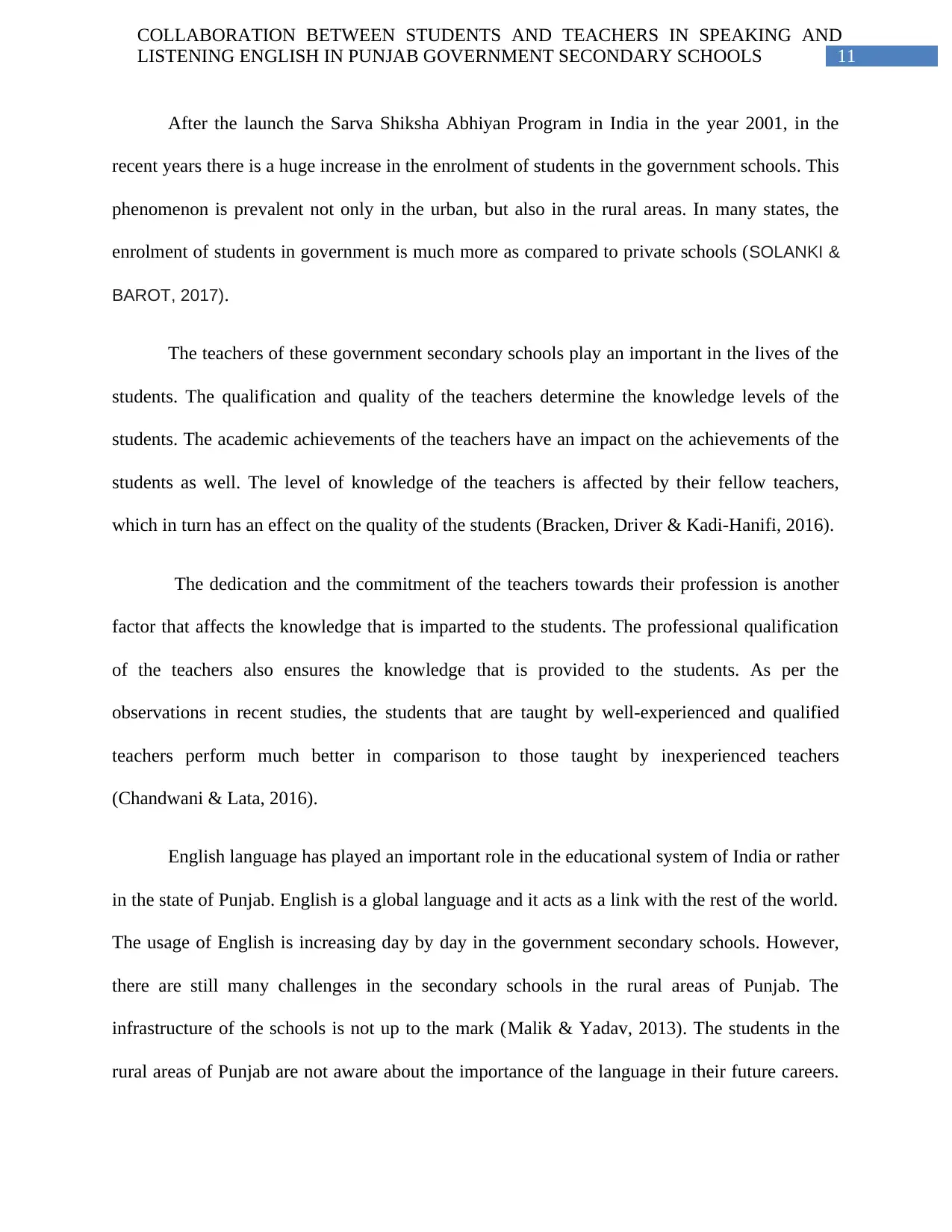
11
COLLABORATION BETWEEN STUDENTS AND TEACHERS IN SPEAKING AND
LISTENING ENGLISH IN PUNJAB GOVERNMENT SECONDARY SCHOOLS
After the launch the Sarva Shiksha Abhiyan Program in India in the year 2001, in the
recent years there is a huge increase in the enrolment of students in the government schools. This
phenomenon is prevalent not only in the urban, but also in the rural areas. In many states, the
enrolment of students in government is much more as compared to private schools (SOLANKI &
BAROT, 2017).
The teachers of these government secondary schools play an important in the lives of the
students. The qualification and quality of the teachers determine the knowledge levels of the
students. The academic achievements of the teachers have an impact on the achievements of the
students as well. The level of knowledge of the teachers is affected by their fellow teachers,
which in turn has an effect on the quality of the students (Bracken, Driver & Kadi-Hanifi, 2016).
The dedication and the commitment of the teachers towards their profession is another
factor that affects the knowledge that is imparted to the students. The professional qualification
of the teachers also ensures the knowledge that is provided to the students. As per the
observations in recent studies, the students that are taught by well-experienced and qualified
teachers perform much better in comparison to those taught by inexperienced teachers
(Chandwani & Lata, 2016).
English language has played an important role in the educational system of India or rather
in the state of Punjab. English is a global language and it acts as a link with the rest of the world.
The usage of English is increasing day by day in the government secondary schools. However,
there are still many challenges in the secondary schools in the rural areas of Punjab. The
infrastructure of the schools is not up to the mark (Malik & Yadav, 2013). The students in the
rural areas of Punjab are not aware about the importance of the language in their future careers.
COLLABORATION BETWEEN STUDENTS AND TEACHERS IN SPEAKING AND
LISTENING ENGLISH IN PUNJAB GOVERNMENT SECONDARY SCHOOLS
After the launch the Sarva Shiksha Abhiyan Program in India in the year 2001, in the
recent years there is a huge increase in the enrolment of students in the government schools. This
phenomenon is prevalent not only in the urban, but also in the rural areas. In many states, the
enrolment of students in government is much more as compared to private schools (SOLANKI &
BAROT, 2017).
The teachers of these government secondary schools play an important in the lives of the
students. The qualification and quality of the teachers determine the knowledge levels of the
students. The academic achievements of the teachers have an impact on the achievements of the
students as well. The level of knowledge of the teachers is affected by their fellow teachers,
which in turn has an effect on the quality of the students (Bracken, Driver & Kadi-Hanifi, 2016).
The dedication and the commitment of the teachers towards their profession is another
factor that affects the knowledge that is imparted to the students. The professional qualification
of the teachers also ensures the knowledge that is provided to the students. As per the
observations in recent studies, the students that are taught by well-experienced and qualified
teachers perform much better in comparison to those taught by inexperienced teachers
(Chandwani & Lata, 2016).
English language has played an important role in the educational system of India or rather
in the state of Punjab. English is a global language and it acts as a link with the rest of the world.
The usage of English is increasing day by day in the government secondary schools. However,
there are still many challenges in the secondary schools in the rural areas of Punjab. The
infrastructure of the schools is not up to the mark (Malik & Yadav, 2013). The students in the
rural areas of Punjab are not aware about the importance of the language in their future careers.
⊘ This is a preview!⊘
Do you want full access?
Subscribe today to unlock all pages.

Trusted by 1+ million students worldwide
1 out of 17
Related Documents
Your All-in-One AI-Powered Toolkit for Academic Success.
+13062052269
info@desklib.com
Available 24*7 on WhatsApp / Email
![[object Object]](/_next/static/media/star-bottom.7253800d.svg)
Unlock your academic potential
Copyright © 2020–2025 A2Z Services. All Rights Reserved. Developed and managed by ZUCOL.





